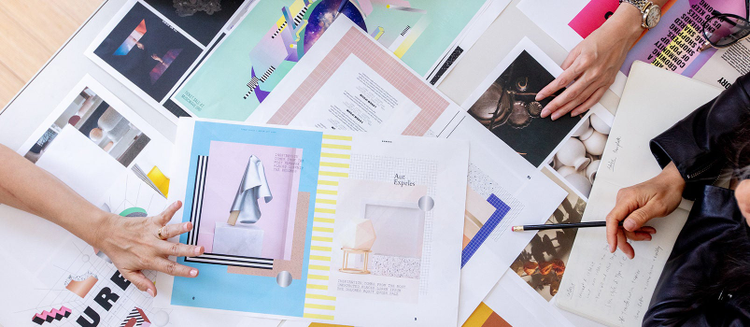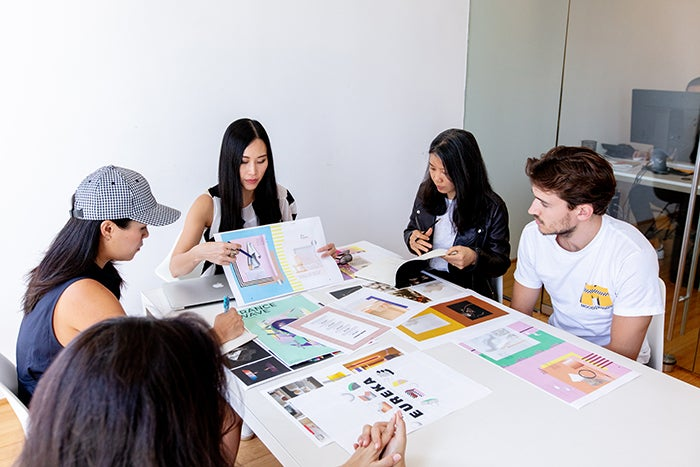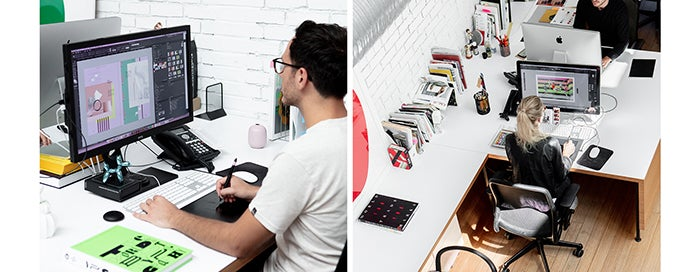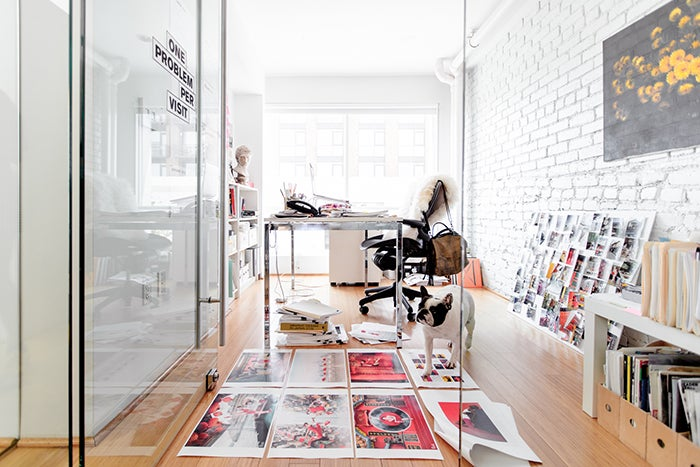Inspiration and InDesign with Design Army
Celebrating the past, present and future of InDesign.

Design Army’s team took on the task of showcasing visual trends in the past 20 years of publishing design. Photo credit: Design Army.
Design Army is an award-winning graphic design firm located in Washington, D.C. Their portfolio consists of everything hyper-creative: from rethinking the Hong Kong Ballet to chasing fashion from Paris to Bangkok. As users of Adobe Stock, they previously showed how you can take beautiful stock assets and unleash your creativity. Now they’re trying their hand at the other side of the screen by creating templates for Adobe Stock to celebrate the 20th Anniversary of InDesign. We sat down with Creative Director Pum Lefebure to talk about their process and how technology impacts their art.
What was your early relationship with Adobe?
I was first introduced to Adobe as a design student. Twenty-plus years ago, design as a practice was just starting to shift from traditional typesetting to desktop publishing. When Adobe Illustrator and Photoshop came out in the ’80s, the change was dramatic. It became far easier to integrate various aspects of a design project. So, when InDesign became available, the level of integration and intuition was so seamless that I switched to work exclusively with Adobe products. Today, Adobe plays an integral role in our team’s daily creative process.
What were your early impressions about Adobe Stock compared to now?
When you hear the word “stock,” you think generic. When we started to dive into Adobe Stock and the potential it provides, the high-quality, innovative images were nothing like the stock photography we as an industry have come to know. This has saved us a lot of time, not to mention client time and money. We quickly saw how valuable Adobe Stock is to designers, especially newer designers looking for inspiration and precision they can creatively build upon.

Photo credit: Design Army.
How have creating templates change your design approach?
Each one of our templates was inspired by the past, present, and future of design. We sought inspiration from David Carson and the type design style of the ’90s, the Memphis design movement and all of its color and graphic glory, as well as the futuristic and the abstract. We drew everything in InDesign. These templates are a jumping-off point for designers — a kit of parts, if you will, so designers are able to utilize the templates and their distinct elements in a way that suits the creative sensibilities of the user.
Can you tell us about your relationship with InDesign over time? How has it influenced your creative process?
Adobe InDesign is one of the most-used apps in our office. We use it to design for print and digital media — everything from posters, magazines, brochures, and moodboards and storyboards. If anything, our relationship with InDesign has become more reliant each day.
InDesign’s flexibility lets us view our projects and the big picture. For example, when we’re designing publications, we are, quite literally, able to zoom out and assess the flow of the publication. We’re also able to look at how the design elements create a sense of rhythm from page to page and how our use of color creates interest within the layout. If we’re unhappy with the flow, it’s easy to shift pages around to get a feel for what might work. Or, if we’re not satisfied with a typeface, we can easily change it throughout the document with paragraph styles. InDesign’s flexibility has allowed us to be quite nimble when we create.

Photo credit: Design Army.
What is one thing you walked away with after exploring the history of InDesign?
I have experienced the history and evolution of InDesign firsthand. As a firm and a creative team, we’ve used InDesign since the beginning. With each update, InDesign simplifies our workflow and makes it easier to push ourselves to be better.
Where else do you get inspiration? What helps you continue your creativity?
Architecture, art, food, fashion — you name it, I am inspired by it all. Yet, above all else, travel is my greatest source of inspiration. Sometimes you have to go offline to gain human experience. I’m a very tactical person, so I prefer to experience things in real life. I’d much rather touch a fabric, taste a food, or smell the ocean air in person, than do so digitally — like we can do so easily today. For example, going to a museum and seeing the original work is never the same as seeing a piece of art in a Google search, a book, or an article. As designers, we have a responsibility to tap into the sensory.
How do you balance the different kinds of creative projects your agency takes on, from the more traditional print design to the artistic creative direction?
For us, variety is key. We pride ourselves on our ability to solve creative problems through the lens of design — for any client or project. Whether it’s an advertising campaign for the Hong Kong Ballet, packaging for a drink launching into a new market, costume and experiential design, or branding for a global corporation, it’s critical that we, as an agency, have our hands in all aspects of design. That breadth and variety are what make us good and keep us different.
Where do you see Design Army moving in the future?
We are constantly rethinking everything. We must understand how our design training can work with the future. We are learning new skills and adapting all the time. Learning to adopt, accept, and move with the future is crucial, and it is all about creating emotional connections with the audience. We live in an economy of caring and, as such, we strive to capture people on a deeper, more emotional level. The world is a very noisy place, and design, as a word, is not cosmetic. We must be more thoughtful, more connected, and more meaningful than ever before.

Photo credit: Design Army.
Do you have any advice for new designers or designers trying new projects/software?
The software should never hold you back. Good design is about good ideas. If you have a strong design foundation and creative ideas, the software is just a vehicle for you to execute your work. Nowadays, it’s easy to learn new software through tutorials. Watch tutorials. Play with the software. Experiment. Learn by doing. Push yourself to do something new. The more you do, the better you’ll get.
Experiment with Design Army’s templates collection and get creative! And if you want to try out more InDesign templates, check out the full collection on Adobe Stock.